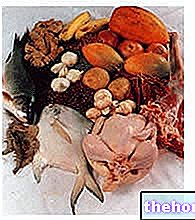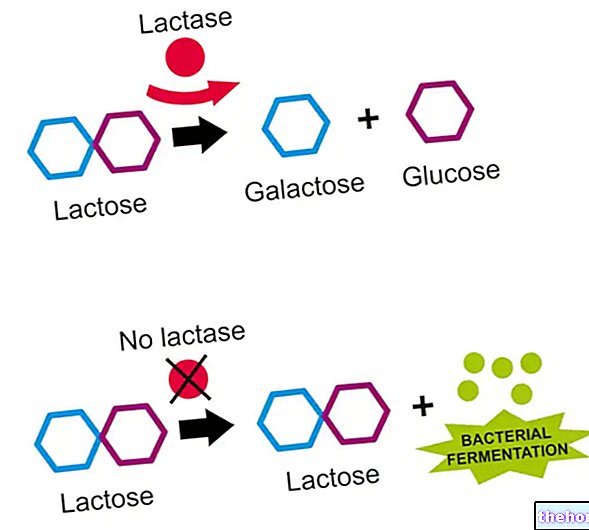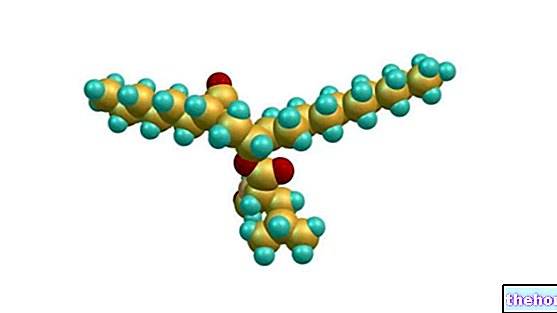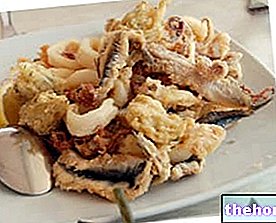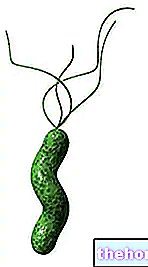- Milk and derivatives (dairy products in general)
- Foods that contain milk powder, as a preservative additive - thickener.

Lactose is a disaccharide glucide, that is a dimer composed of two simple sugars, respectively glucose and galactose.
Lactose is a unique carbohydrate of its kind, it derives from milk and its presence in food is a prerogative of those that (for one reason or another) derive or contain it.
Milk is an indispensable food only in the lactation phase of mammals, therefore, evolution and individual subjectivity play an essential role in the ability to digest it or not.
For the most part, the difficulty in digesting milk derives from an insufficiency (transient or permanent) of a specific enzyme for breaking down lactose: lactase.
Lactase is a biological catalyst present on the brush border of enterocytes (cells of the intestine) which allows to split the glucose + galactose dimer and thus make it absorbable by the intestine.
In the absence or deficiency of this enzyme, lactose is neither digested nor absorbed by the intestine; the consequent intestinal fermentation of lactose is responsible for the typical symptoms of food intolerance.
It is equally true that the ability to digest lactose also derives from the maintenance of enzymatic activity; therefore, in the long term, interrupting its intake could lead to a reduction in tolerability to this sugar.
For milk lovers, who however find it difficult to tolerate lactose, there are products called "delactosed", that is, artificially undergo the hydrolysis of lactose to the advantage of the intolerant consumer.
It often happens that professionals and laymen ask themselves:
"why continue to promote the consumption of milk if lactose intolerance is such a widespread condition?'
my (absolutely personal) answer is that:
"Milk, although it contains lactose (an often non-digestible carbohydrate), is a food that provides a good amount of essential nutrients; among these, we remember proteins with a high biological value, riboflavin or vitamin B2 and calcium, not to mention that boasting 87% water, milk favors the maintenance of a good state of hydration. In my opinion, it is a very useful food for achieving some recommended rations; therefore, if well tolerated, I believe it is a " excellent habit to use it as long as it is proportionate to one's dietary needs ".
Note: a minor part of the adverse reactions related to the consumption of milk and its derivatives relate to allergy to its proteins.
There is a strong heterogeneity in the degree of tolerance and digestion capacity of lactose; these are mostly genetic and racial differences, therefore subjective and influenced by eating habits or some intestinal pathologies.
What is certain is that lactose is not a uniquely digestible nutrient; therefore its spread in food should be limited or at least well marked.
The table shows that the lactose content in milk is almost ubiquitous among the various species; therefore, it can be deduced that the variability of the symptoms among the different intolerant subjects depends above all on the portions and the level of lactase deficiency rather than on the type of milk consumed.
Dairy products, on the other hand, are all those foods that derive from the processing of milk and that still contain significant quantities of lactose, despite undergoing industrial processes and / or bacterial fermentation:
We remind you that the simple classification between dairy and non-dairy products does not guarantee the presence or absence of lactose from the product, but only the extent of its concentration.
Furthermore, I believe it is necessary to underline that MOST sweet snacks, some bakery products (industrial and otherwise), almost all pastry products (especially fresh but not only), and even some alcoholic beverages, on the label show the presence of milk or derivatives.
) is a food product often used as an additive ingredient; it is obtained by heat dehydration (max 3.2% of water) and contains lactose up to 56% of the total weight. The low skimmed milk is very common in the food industry, as it is a product capable of:
- Compact and solidify, drastically reducing the amount of free water by absorption; milk powder is able to bind 100% of its weight in raw foods and up to 120% in cooked foods
- Keep due to the reduction of free water
- To limit costs, because by binding the water it keeps the weight of the product high, which does not dehydrate, and because it is in itself an economic additive. Furthermore, its addition in cooked products greatly limits the escape of fat.
The addition of skimmed milk powder is allowed in proportions of 10% in raw sausages (such as salami) and 2-4% in cooked sausages (such as mortadella).
There are many foods that contain lactose and are not always easy to identify; in case of intolerance, it is advisable to always and carefully read the food label of all industrial products, paying particular attention to sausages, baked goods, confectionery products and packaged snacks.
Milk, Dairy Products and Cheeses Asiago Brie Burrata Caciocavallo Rennet Camembert Cheddar Milk Cream Crescenza Emmental Feta Milk Flakes Fontina Herbal Cheeses Lean Cheeses Cheeses rich in calcium Gorgonzola Gouda Grana Padano Gruyere Kéfalair Adapted milk Artificial milk Condensed milk Asphyxiated milk Goat's milk Sheep's milk Rice milk Soy milk Powdered milk and concentrated milk Skimmed and semi-skimmed milk Lactose-free milk Milk Vegetable milk Dairy products Lerdammer Mascarpone Montasio Buffalo mozzarella Mozzarella Whipped cream Cooking cream Fresh cream Parmigiano Reggiano Pecorino Philadelphia Primo Sale Provolone Ricotta Robiola Roquefort Scamorza Sottilette Squacquerone Taleggio Tomino Yogurt OTHER ARTICLES MILK AND DERIVATIVES Categories Alcoholic foods Meat Cereals and derivatives Sweeteners Sweets Offal Fruit Dried fruit Milk and derivatives Legumes Oils and fats Fish and fishery products Cold cuts S pezie Vegetables Health recipes Appetizers Bread, Pizza and Brioche First courses Second courses Vegetables and Salads Sweets and Desserts Ice creams and sorbets Syrups, liqueurs and grappa Basic preparations ---- In the kitchen with leftovers Carnival recipes Christmas recipes Light diet recipes Women's Day, Mum, Dad Recipes Functional Recipes International Recipes Easter Recipes Recipes for Celiacs Recipes for Diabetics Recipes for Holidays Recipes for Valentine's Day Recipes for Vegetarians Protein Recipes Regional Recipes Vegan Recipes

